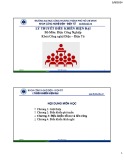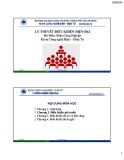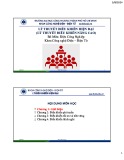Lecture Notes Lecture Notes
Fundamentals of Control Systems Fundamentals of Control Systems
Instructor: Assoc. Prof. Dr. Huynh Thai Hoang Department of Automatic Control Faculty of Electrical & Electronics Engineering Ho Chi Minh City University of Technology Email: hthoang@hcmut.edu.vn
huynhthaihoang@yahoo.com Homepage: www4.hcmut.edu.vn/~hthoang/
6 December 2013
© H. T. Hoang - www4.hcmut.edu.vn/~hthoang/
1
Chapter 5 Chapter 5
ANALYSIS OF CONTROL SYSTEM ANALYSIS OF CONTROL SYSTEM
PERFORMANCE PERFORMANCE
6 December 2013
© H. T. Hoàng - www4.hcmut.edu.vn/~hthoang/
2
Content Content
Performance criteria Steady state error Transient response Transient response The optimal performance index Relationship between frequency domain performances and Relationship between frequency domain performances and
6 December 2013
© H. T. Hoàng - www4.hcmut.edu.vn/~hthoang/
3
time domain performances.
Performance criteria Performance criteria
6 December 2013
© H. T. Hoàng - www4.hcmut.edu.vn/~hthoang/
4
Performance criteria: Steady state error Performance criteria: Steady state error
yfb(t) (t)
ess
Y(s) R(s) E(s)
r(t)
G(s) +_
Yfb(s)
e(t)
ess
t
0 0
Error: is the difference between the set point (input) and the Error: is the difference between the set-point (input) and the
H(s)
feedback signal.
te )(
tr )(
t )(
sE )(
sR )(
sY )(
y fb
fb
Steady-state error: is the error when time approaching infinity.
sE E
s )( )(
e ss
e ss
lim li s 0
lim te li )( )( t
6 December 2013
© H. T. Hoàng - www4.hcmut.edu.vn/~hthoang/
5
Percent of Overshoot (POT) Performance criteria –– Percent of Overshoot (POT) Performance criteria
Overshoot: refers to an output exceeding its steady-state value. Overshoot: refers to an output exceeding its steady state value
y(t)
y(t)
overshoot overshoot
ymax
ymax yss
yss
yss
yss
t
No overshoot
t
0
0
Percentage of Overshoot (POT) is an index to quantify the
y
y
ss
%100
POT
max ssy y
6 December 2013
© H. T. Hoàng - www4.hcmut.edu.vn/~hthoang/
6
overshoot of a system, POT is calculated as: overshoot of a system, POT is calculated as:
Settling time (t ): is the time required for the response of a Settling time (ts): is the time required for the response of a system to reach and stay within a range about the steady- state value of size specified by absolute percentage of the steady-state value (usually 2% or 5%)
Settling time and rise time Performance criteria –– Settling time and rise time Performance criteria
Rise time (tr):
is the time required for the response of a
y(t)
y(t)
(1+)yss yss (1)yss
yss 0.9yss
t
t
0.1yss 0 0
0
tr
ts
6 December 2013
© H. T. Hoàng - www4.hcmut.edu.vn/~hthoang/
7
system to rise from 10% to 90% of its steady-state value. system to rise from 10% to 90% of its steady state value
state error Steady--state error Steady
6 December 2013
© H. T. Hoàng - www4.hcmut.edu.vn/~hthoang/
8
state error Steady--state error Steady
R(s) R( ) Y(s) Y( ) E(s) E( )
G(s) +_
Yfb(s) Y ( )
Error expression:
sE )(
sR )( )( sHsG )(
1
Steady-state error:
sE
s )(
e ss
lim s 0
lim s 0
1
sR s )( )( )( )( )( sHsG
H(s)
Remark: Steady-state error not only depends on the structure p and parameters of the system but also depends on the input signal.
6 December 2013
© H. T. Hoàng - www4.hcmut.edu.vn/~hthoang/
9
p p y
state error to step input Steady--state error to step input Steady
Step input: Step input:
sR sR
s s
/1)( /1)(
Steady-state error:
e ss
1 pK1 K 1
K
sHsG )( )(
p
lim s 0
yfb(t)
yfb(t)
1
1
t
t
0
0
with (position constant)
6 December 2013
© H. T. Hoàng - www4.hcmut.edu.vn/~hthoang/
10
G(s)H(s) does not have G(s)H(s) does not have any deal integral factor G(s)H(s) has at least 1 G(s)H(s) has at least 1 ideal integral factor
state error to ramp input Steady--state error to ramp input Steady
Ramp input: Ramp input:
sR sR
2/1)( s /1)( s
K
sG
sHs )( )(
v
lim s s 0 0
1 e ss K vK
yfb(t)
yfb(t)
yfb(t)
r(t)
r(t)
r(t)
ess 0 e 0
ess = 0 0
e(t)
t
t
t
0
0
0
G(s)H(s) has 1 ideal G(s)H(s) has 1 ideal
G(s)H(s) does not have G(s)H(s) does not have deal integral factor
integral factor
G(s)H(s) has at least G(s)H(s) has at least 2 ideal integral factors
6 December 2013
© H. T. Hoàng - www4.hcmut.edu.vn/~hthoang/
11
with (velocity constant)
state error to parabolic input Steady--state error to parabolic input Steady
Parabolic input: t b li
3/1)(R 3/1)( sR s
P i
sHsGs sHsGs )( )( )( )(
K K a
lim 2 lim s 0
with with
1 e e ss K
a
yfb(t)
yfb(t)
yfb(t)
r(t)
r(t)
r(t)
ess0 ss
ess 0 ess= 0
e(t)
t
t
t
0
0
0
G(s)H(s) has 2 ideal G(s)H(s) has 2 ideal
G(s)H(s) has less than G(s)H(s) has less than 2 ideal integral factors
G(s)H(s) has more than G(s)H(s) has more than 2 ideal integral factors
integral factors
6 December 2013
© H. T. Hoàng - www4.hcmut.edu.vn/~hthoang/
12
(acceleration constant )
Transient response Transient response
6 December 2013
© H. T. Hoàng - www4.hcmut.edu.vn/~hthoang/
13
order system First--order system First
K 1Ts
Transfer function:
sG )( )(
1 1
K Ts T
First order system has 1 real pole:
p 1 1
Transient response:
sY )(
sGsR )( )(
.
1 s s
1 T T K 1Ts 1 Ts
R(s) Y(s)
/Tte
6 December 2013
© H. T. Hoàng - www4.hcmut.edu.vn/~hthoang/
14
ty )( K 1( )
order system (cont’) First--order system (cont’) First
y(t)
Im s
(1+).K K (1).K
Re s
0.63K
0
1/T
t
0
T
ts
Pole – zero plot Pole zero plot of a first order system Transient response Transient response of the first order
/Tte e
6 December 2013
© H. T. Hoàng - www4.hcmut.edu.vn/~hthoang/
15
ty )( )( ty K K 1( 1( ) )
First--order system First
Remarks order system –– Remarks
First order system has only one real pole at (1/T),
its
Time constant T: is the time required for the step response of f
transient response doesn’t have overshoot.
i d f th ti t T i th t
The further The further
t Ti the system to reach 63% its steady-state value.
the pole (1/T) of the pole ( 1/T) of
Settling time of the first order system is:
lnT lT
ts t
1
the system is from the the system is from the imaginary axis, the smaller the time constant and the faster the time response of the system.
6 December 2013
© H. T. Hoàng - www4.hcmut.edu.vn/~hthoang/
16
0.05 (5% criterion) where = 0 02 (2% criterion) or = 0 05 (5% criterion) where 0.02 (2% criterion) or
order system First--order system First
The further the pole of the system is from the imaginary axis, the time the time
The relationship between the pole and the time response The relationship between the pole and the time response The relationship between the pole and the time response The relationship between the pole and the time response
the time constant the time constant and the faster and the faster
Im s
y(t)
K
Re s
0
t
0
the smaller the smaller response of the system.
6 December 2013
© H. T. Hoàng - www4.hcmut.edu.vn/~hthoang/
17
Transient response Transient response of the first order Pole – zero plot Pole zero plot of a first order system
order oscillating system Second--order oscillating system Second
22 sT
Ts
1
K 2
The transfer function of the second-order oscillating system:
0 , 0
)1 )1
sG )( )( sG
( ( n
2
1 T
22 sT
Ts
1
s
K 2
2 nK 2 ns 2 n
The system has two complex conjugate poles:
2 j 1
n
n
p 2,1
sY sY )( )(
sGsR )( )( )( )( sGsR
Transient response: Transient response:
2 2
1 . . ss
2 nK 2 2 ns 2 n
tn
e
)( ty ty )(
K K
sin sin
) )
t t
2 ( 1 ( 1
(cos (cos ) )
n
R(s) Y(s)
1
2
1 1
6 December 2013
© H. T. Hoàng - www4.hcmut.edu.vn/~hthoang/
18
order oscillating system (cont’) Second--order oscillating system (cont’) Second
y(t)
Im s
cos =
2 j 1
n
n
(1+).K K ) (1).K (
Re s R
0
n
2 j 1 1 n j
t
0
ts
6 December 2013
© H. T. Hoàng - www4.hcmut.edu.vn/~hthoang/
19
Pole – zero plot of a second order oscillating system Transient response of a second order oscillating system
Second--order oscillating system Second
Remark order oscillating system –– Remark
A second order oscillation system has two conjugated A second order oscillation system has two conjugated
t
= 0 = 0.2
= 0.4
If = 0, transient response i If 0 t is a stable oscillation signal at the frequency n n is called natural oscillation frequency. ,
If 0<<1, transient
= 0.6 = 0.6
response is a decaying oscillation signal is called damping constant, , p g the larger the value , (the closer the poles are to the real axis) the faster the real axis) the faster the response decays.
6 December 2013
© H. T. Hoàng - www4.hcmut.edu.vn/~hthoang/
20
complex poles, its transient response is a oscillation signal.
Transient response of the second order oscillating system Transient response of the second order oscillating system
Second--order oscillating system Second Overshoot order oscillating system –– Overshoot
has overshoot.
POT
%100
1
exp
. 2
The larger the value ,
)
%
The percentage of overshoot:
( ( T O P
The smaller the value , (the closer the poles are (the closer the poles are to the imaginary axis) the larger the POT
The relationship The relationship between POT and
6 December 2013
© H. T. Hoàng - www4.hcmut.edu.vn/~hthoang/
21
(the closer the poles are to t e ea a s) t e to the real axis) the smaller the POT.
Second--order oscillating system Second
Settling time order oscillating system –– Settling time
Settling time:
t
s
3 3 n
5% criterion:
t
s
4 n
6 December 2013
© H. T. Hoàng - www4.hcmut.edu.vn/~hthoang/
22
2% criterion:
order oscillating system Second--order oscillating system Second
Th f th th th f t t
Im s Im s
y(t) y(t)
K
cos = cos =
Re s R
0
t
Relationship between pole location and transient response Relationship between pole location and transient response Relationship between pole location and transient response Relationship between pole location and transient response The 2nd order systems that have the poles located in the same rays starting from the origin have the same damping constant, then the percentage of overshoots are the same. The further h th the poles from the origin, the shorter the settling time.
0 Transient response of a second Transient response of a second order oscillating system
6 December 2013
© H. T. Hoàng - www4.hcmut.edu.vn/~hthoang/
23
Pole – zero plot of a second Pole zero plot of a second order oscillating system
order oscillating system Second--order oscillating system Second
th i
Th
th
ll
l
i
i
Relationship between pole location and transient response (cont’) Relationship between pole location and transient response (cont ) Relationship between pole location and transient response (cont ) Relationship between pole location and transient response (cont’) The 2nd order systems that have the poles located in the same distance from the origin have the same natural oscillation frequency. The closer the poles to the imaginary axis, the smaller t l th f the damping constant, then the higher the POT.
s Im s
y(t) y(t)
K
n
Re s R
0
t
0
Pole zero plot of a second Pole – zero plot of a second order oscillating system
Transient response of a second Transient response of a second order oscillating system
6 December 2013
© H. T. Hoàng - www4.hcmut.edu.vn/~hthoang/
24
order oscillating system Second--order oscillating system Second
Relationship between pole location and transient response (cont ) Relationship between pole location and transient response (cont’) Relationship between pole location and transient response (cont ) Relationship between pole location and transient response (cont’)
ttli
th
th
th
th
ti
f
l
The 2nd order systems that have the poles located in the same distance from the imaginary axis have the same n, then the settling time are the same. The further the poles from the real l Th f axis, the smaller the damping constant, then the higher the POT
s Im s
y(t) y(t)
K
Re s R
0
n
t
0
Pole zero plot of a second Pole – zero plot of a second order oscillating system
Transient response of a second Transient response of a second order oscillating system
6 December 2013
© H. T. Hoàng - www4.hcmut.edu.vn/~hthoang/
25
Transient response of high order system Transient response of high order system
High-order systems are the system that have more than 2 poles High-order systems are the system that have more than 2 poles If a high order system have a pair of poles located closer to the
t d t
Th
d
t
f
i
i
l
imaginary axis than the others then the high order system can be approximated to a second order system. The pair of poles d nearest to the imaginary axis are called the dominant poles.
s Im s
y(t) y(t)
R Response of high f hi h order system
Re s Re s
0
Response of second order system with the dominant poles the dominant poles
t
0
High order systems High order systems have more than 2 poles
A high order system can be A high order system can be approximated by a 2nd order system
6 December 2013
© H. T. Hoàng - www4.hcmut.edu.vn/~hthoang/
26
Performance indices Performance indices
6 December 2013
© H. T. Hoàng - www4.hcmut.edu.vn/~hthoang/
27
Integral performance indices Integral performance indices
IAE criterion IAE criterion
te )( dt
J IAE
(Integral of the Absolute Magnitude of the Error )
0
ISE criterion ISE criterion
2 2 te
)( dt
J ISE
0
ITAE criterion
(Integral of the Square of the Error)
tet tet
)( dt )( dt
J ITAE J
0
6 December 2013
© H. T. Hoàng - www4.hcmut.edu.vn/~hthoang/
28
(Integral of Time multiplied by the Absolute Value of the Error)
A control system is optimal when the selected performance A control system is optimal when the selected performance
707
systems Optimal systems Optimal
index is minimized Second order system:
707
.0 5.0 50 .0
minIAEJ minISEJ i J minITAE J
=0.3
y(t)
=0.5
=0.707
=0.9
t
0 0
when when when
6 December 2013
© H. T. Hoàng - www4.hcmut.edu.vn/~hthoang/
29
Transient response of second order systems
ITAE is usually used in design of control system ITAE is usually used in design of control system
An n-order system is optimal according to ITAE criterion if the
ITAE optimal control ITAE optimal control
6 December 2013
© H. T. Hoàng - www4.hcmut.edu.vn/~hthoang/
30
denominator of its transfer function has the form:
Optimal response according to ITAE criterion Optimal response according to ITAE criterion
y(t)
1st order system 1st
d
t
2nd order system
3rd order system
4th order system
t
0
6 December 2013
© H. T. Hoàng - www4.hcmut.edu.vn/~hthoang/
31
ITAE optimal control (cont’) ITAE optimal control (cont’)
Relationship between frequency domain Relationship between frequency domain
time domain performances performances & time domain performances performances &
6 December 2013
© H. T. Hoàng - www4.hcmut.edu.vn/~hthoang/
32
Relationship between frequency response & Relationship between frequency
steady state error response & steady state error
Y(s) Y(s) R(s) R(s)
K
sHsG )(
(
jHjG ) ( )
p
lim s 0
lim)( 0
K
(
jHjGj ) ) (
v
lim)( 0
sHsGs )( lim s 0
2
K
(
(
j )
jHjG ) ( )
a
lim)( 0
2 sHsGs lim )( 0 s
6 December 2013
© H. T. Hoàng - www4.hcmut.edu.vn/~hthoang/
33
G(s) +
Relationship between frequency response & Relationship between frequency
steady state error response & steady state error
Y(s) Y( ) R(s) R( )
Steady state error of the closed-loop system depends on the low
G(s) +
the open-loop system at
magnitude response of frequencies but not at high frequencies.
The higher the magnitude response of the open-loop system at low frequencies, the smaller the steady-state error of the closed-loop system.
In particular, if the magnitude response of the open-loop system is infinity as frequency approaching zero, then the steady-state error of the closed-loop system to step input is zero.
6 December 2013
© H. T. Hoàng - www4.hcmut.edu.vn/~hthoang/
34
p y
Relationship between frequency response & Relationship between frequency
transient response response & transient response
Y(s) Y(s) R(s) R(s)
G(s) +
(
)
1
jG
In the frequency range <c , because
1
)
jGcl (
1
jG ( jG (
) )
jG ( ) jG ( )
)
1
then:
In the frequency range >c , because
jG jG ( (
) )
) )
jGcl jG ( (
1
jG ( j ( ( ) ) jG 1
j ( ( ) ) jG jG ( )
Bandwidth of the closed loop system is approximate the gain Bandwidth of the closed-loop system is approximate the gain
then:
6 December 2013
© H. T. Hoàng - www4.hcmut.edu.vn/~hthoang/
35
crossover frequency of the open-loop system.
Relationship between frequency response & Relationship between frequency
transient response response & transient response
Bode plot of a open-loop system
Bode plot of the corresponding closed-loop system
6 December 2013
© H. T. Hoàng - www4.hcmut.edu.vn/~hthoang/
36
Relationship between frequency response & Relationship between frequency
transient response response & transient response
Y(s) Y(s) R(s) R(s)
The higher the gain crossover frequency of open-loop system, the wider the bandwidth of closed-loop system the faster the response of close-loop system, the shorter the settling time.
t
qd
c
4 4 c
The higher the phase margin of the open-loop system, the
G(s) +
p y g g p p
6 December 2013
© H. T. Hoàng - www4.hcmut.edu.vn/~hthoang/
37
f smaller the POT of closed-loop system. In most of the cases, if the phase margin of the open-loop system is larger than 600 then the POT of the closed-loop system is smaller than 10%.
Ex: relationship between gain crossover Ex: relationship
between gain crossover frequency &
settling time frequency & settling time
Y(s) Y(s) R(s) R(s)
)( sG
10 08.0)(1 080)(1
s
)1 )1
s
s 10( 1.0(
6 December 2013
© H. T. Hoàng - www4.hcmut.edu.vn/~hthoang/
38
G(s) +
between gain crossover frequency and settling time Ex: relationship between gain crossover frequency and settling time Ex: relationship
Y(s) Y(s) R(s) R(s)
sG )(
s s
)1 )1
50 s 1.0( 1.0( s
6 December 2013
© H. T. Hoàng - www4.hcmut.edu.vn/~hthoang/
39
G(s) +
Example of relationship between phase margin and POT Example of relationship between phase margin and POT
Y(s) Y(s) R(s) R(s)
6
)( sG
s s
s 10( 1.0( s
08.0)(1 080)(1
s s
)1 )1
6 December 2013
© H. T. Hoàng - www4.hcmut.edu.vn/~hthoang/
40
G(s) +
of relationship between phase margin and POT (cont’) Ex Ex of relationship between phase margin and POT (cont’)
Y(s) Y(s) R(s) R(s)
sG )(
s
6 s 1.0(
)1
6 December 2013
© H. T. Hoàng - www4.hcmut.edu.vn/~hthoang/
41
G(s) +

![Bài giảng Lý thuyết điều khiển TS. Nguyễn Thu Hà [mới nhất]](https://cdn.tailieu.vn/images/document/thumbnail/2025/20250515/hoatrongguong02/135x160/241747304992.jpg)






















![Đề cương đề tài nghiên cứu khoa học [chuẩn nhất/mới nhất]](https://cdn.tailieu.vn/images/document/thumbnail/2025/20251117/duong297/135x160/26111763433948.jpg)

